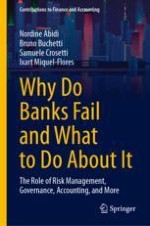
2024 | OriginalPaper | Buchkapitel
1. The Role of Banking
verfasst von : Nordine Abidi, Bruno Buchetti, Samuele Crosetti, Ixart Miquel-Flores
Erschienen in: Why Do Banks Fail and What to Do About It
Verlag: Springer Nature Switzerland
Aktivieren Sie unsere intelligente Suche, um passende Fachinhalte oder Patente zu finden.
Wählen Sie Textabschnitte aus um mit Künstlicher Intelligenz passenden Patente zu finden. powered by
Markieren Sie Textabschnitte, um KI-gestützt weitere passende Inhalte zu finden. powered by